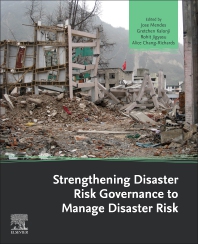
 Description:
Description:
Strengthening Disaster Risk Governance to Manage Disaster Risk presents the second principle from the UNISDR Sendai Framework for Disaster Risk Reduction, 2015-2030. The framework includes discussion of risk and resilience from both a theoretical and governance perspective in light of the ideas that are shaping our common future and presents innovative tools and best practices in reducing risk and building resilience. Combining the applications of social, financial, technological, design, engineering and nature-based approaches, the volume addresses rising global priorities and focuses on strengthening the global understanding of risk governance practices, initiatives and trends. Focusing on disaster risk governance at the national, regional, and global levels, it presents both historic and contemporary issues, asking researchers and governments how they can use technological advances, risk and resilience metrics and modeling, business continuity practices, and past experiences to understand the disaster recovery process and manage risk.
Eds.: José Manuel Mendes | Gretchen Kalonji | Rohit Jigyasu | Alice Chang-Richards |
Table of contents
- Front Matter | Copyright | Contributors | Introduction
- Chapter 1 - Inclusive resilience: A new approach to risk governance | Ortwin Renn
- Chapter 2 - Can cultural resilience be a tool for strengthening community? | Meghan Venable-Thomas
- Chapter 3 - Mainstreaming cultural heritage in disaster risk governance | Rohit Jigyasu
- Chapter 4 - Role of higher education institutions toward effective multi-hazard early warnings in Asia | Kinkini Hemachandra, Richard Haigh and Dilanthi Amaratunga
- Chapter 5 - Using financial instruments and PPP schemes for building resilience to natural disasters | Felix Villalba-Romero and Champika Liyanage
- Chapter 6 - Resilience through flood memory—A comparison of the role of insurance and experience in flood resilience for households and businesses in England | Jessica Lamond and Namrata Bhattacharya-Mis
- Chapter 7 - Moving from response to recovery: What happens to coordination? | Emmanuel Raju
- Chapter 8 - Effects of regulatory frameworks in community resilience: Governance and governability in the Southeastern Pacific coast of Chile | Paula Villagra, Carolina Quintana and Karla Figueroat
- Chapter 9 - Harmonizing policies to enhance cross-border regional resilience of the Guangdong-Hong Kong-Macau Greater Bay Area | Qingqing Feng, S. Thomas Ng and Frank J. Xu
- Chapter 10 - Participatory Geographic Information Systems for integrated risk analysis: A case of Arequipa, Peru | Carlos Zeballos-Velarde
- Chapter 11 - Social capital in disaster recovery: A case study after the 2016 earthquake in Ecuador | Laura Cevallos-Merki and Jonas Joerin
- Chapter 12 - 2017 Coastal El Niño in Peru: An opportunity to analyze the influence of hazard mitigation plans on local resilience | Juan N. Urteaga-Tirado, Sandra Santa-Cruz, ... Marta Vilela
- Chapter 13 - Business continuity as a means to strengthen disaster risk reduction in a coastal community of oyster farmers | Raymond S. Rodolfo and Mark R. Lapus
No. of pages: 162
Language: English
Copyright: © Elsevier 2021
Published: January 11, 2021
Imprint: Elsevier
eBook ISBN: 9780128187517
Paperback ISBN: 9780128187500